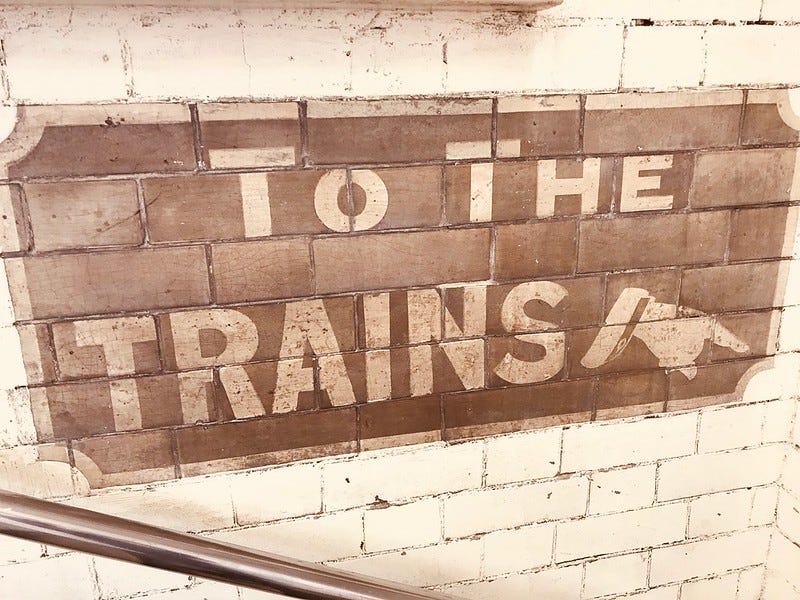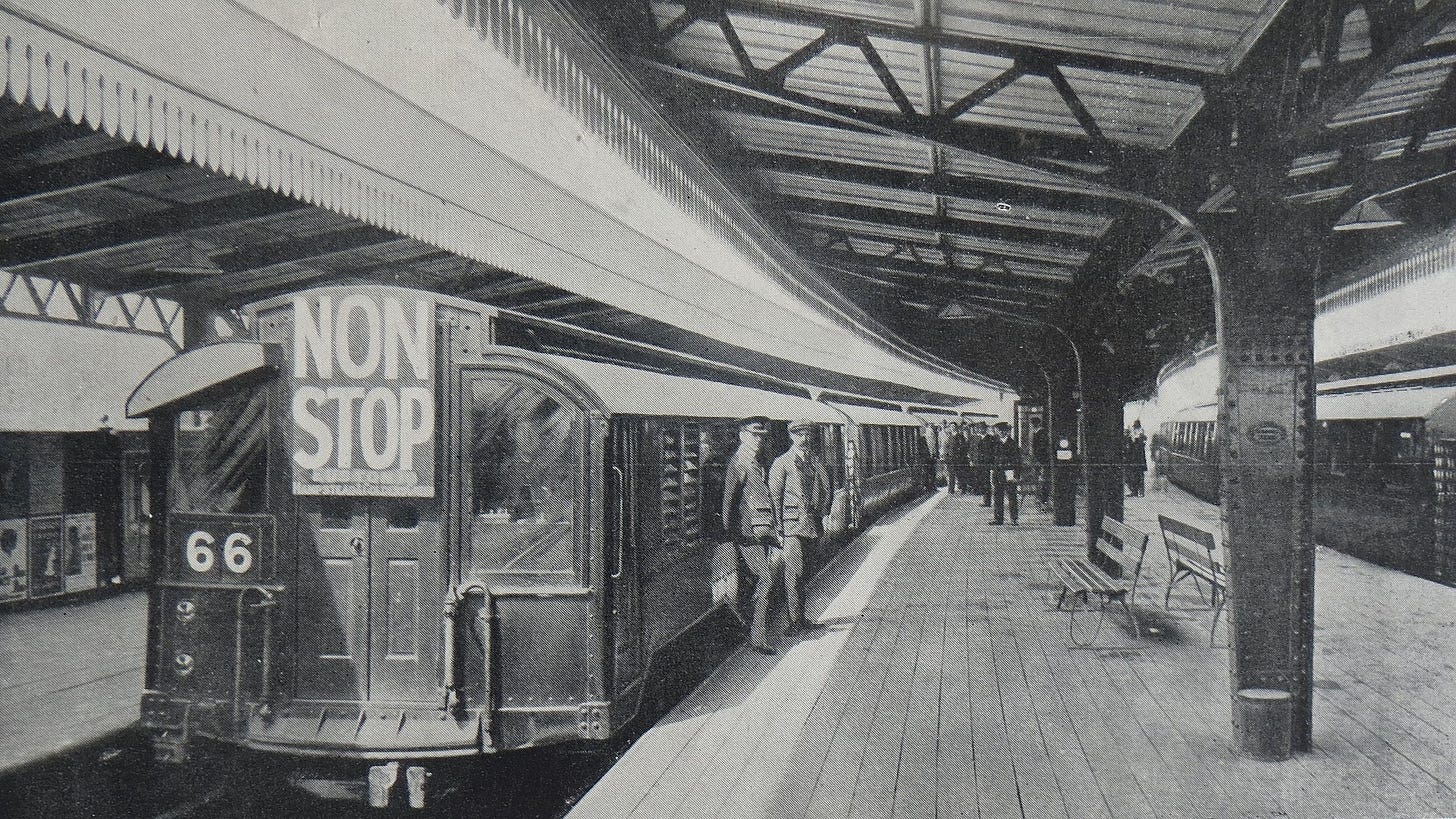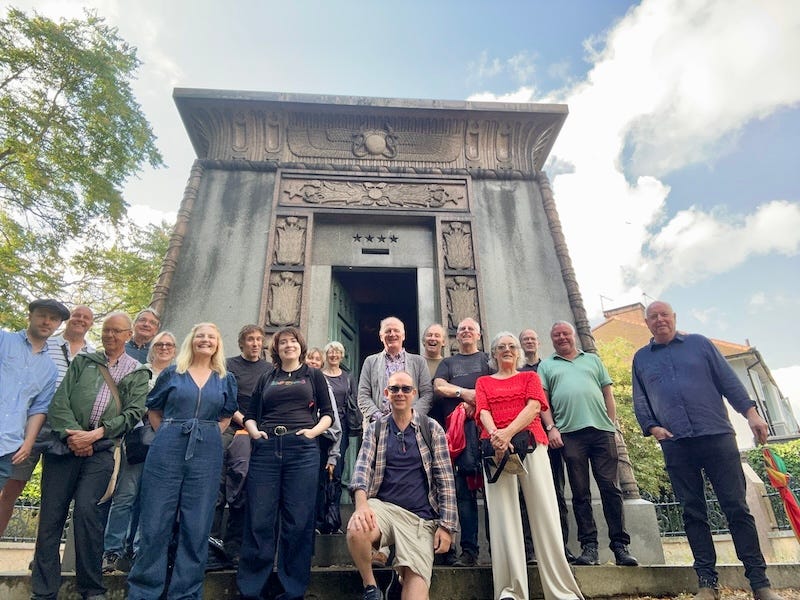A Ride on the Tube in 1911
What was it like to catch the Underground in the early 20th century?
Welcome to Londonist: Time Machine’s Friday newsletter for paying subscribers, with a hefty teaser for everyone else.
Today, a near-universal experience of London: catching a Tube train. But we’re passing through the ticket barrier in good company. Kate Evelyn Isitt was a New Zealand journalist of the early 20th century, who came to England in 1910. She quickly got the London bug, and started writing features about the capital for the Manchester Guardian. Today, I’m going to take a look at an article she wrote about the Tube network in 1911, and see how it compares to the modern experience.
That’s for the main section. First a note on subscriber events, and the History Radar…
Subscriber Events
As a bonus for paid subscribers, I like to arrange occasional events that take readers to unusual historic locations in London. Last weekend, around 20 of us braved the changeable weather for a guided walk through historic Richmond and St Margaret’s (the bit over the river). We ended up somewhere truly special. This is the Kilmorey Mausoleum, a Victorian tomb of magnificent splendour, hiding away behind a wall in St Margarets:
Our guide Andrew George not only unlocked the gate to let us into this private garden, but also allowed us to step inside the tomb itself. Which was… wow!. I’ll tell that story on another occasion. But thanks to Andrew and everybody who came along.
I’ll be arranging more events for paying subscribers in autumn and winter. Meanwhile, we have drinks in an historic London pub on 6 August. If you’re a paying subscriber and want to join us (venue to be decided), email me on matt@londonist.com.
History Radar
Upcoming events for fans of London history.
💂🏽♀️ BEATING RETREAT: More pageantry than proper history, but the Massed Bands of the Household Division present a "military musical spectacular" at Horseguards Parade over the evenings of 15-17 July. It takes the form of a Beating Retreat ceremony, with a theme of 'Heroes'. The Duchess of Edinburgh’s String Orchestra, the State Trumpeters of the Household Cavalry, and the Massed Pipes and Drums all take part.
🥩 SMITHFIELD HISTORY: City of London Guide & Lecturer Jill Finch is at Guildhall Library on 15 July to give a free talk about the history of Smithfield, an area currently in a state of flux as the London Museum prepares to move in and the butchers move out. Hear about its past role as a place of religion, trade, healing, entertainment and sport, but also as a place of public execution. If this interests you, there's also a history-focused walk around Smithfield tomorrow.
🤴🏻👸🏻 TUDOR POWER COUPLES: On 16 July, the London Archives in Clerkenwell hosts author Jo Romero, who discusses her new book, Power Couples of the Tudor Era. From the legendary marriage of Henry VIII and Katherine of Aragon, to the political machinations of Elizabeth I and Robert Dudley, hear the remarkable stories of the dynamic duos whose partnerships shaped the course of English history.
🏛️ TEMPLE BAR: Also on 16 July, another chance to see inside Christopher Wren's Temple Bar, which started life where Fleet Street meets Strand but now stands in Paternoster Square. Access forms part of a two-hour tour of the local area, conducted by Jonathan Wober. 11am-1pm
🐴 CART-MARKING CEREMONY: One of London's quirkier events is the Ceremony of Cart Marking, a 500+ year old tradition by the Worshipful Company of Carmen. On 19 July, see a collection of handcarts, horses and carts, steam-driven vehicles, electric, solar-powered and hydrogen vehicles on display at Guildhall, with Livery Masters and Court Assistants in their official robes, chains and hats.
🇮🇹 LITTLE ITALY: On 20 July, tour guide 'the Haughty Culturalist' leads a walk around the area of Clerkenwell known as Little Italy, whose notable Italian residents included revolutionary Giuseppe Mazzini, the clown Joseph Grimaldi and even the notorious Darby Sabini, of Peaky Blinders fame. Afterwards, enjoy the Sagra -- an Italian fair and food market -- followed by the Procession of our Lady of Mount Carmel. This is thought to be the oldest outdoor Catholic procession in Britain. 1pm (walk), 3.30pm (procession)
A Ride on the Tube in 1911
Let’s catch the Tube 114 years ago, through the eyes of a newcomer to London.
Kate Evelyn Isitt (1876-1948) cut her journalistic teeth writing for New Zealand newspapers, including a stint as the first editor of the women’s page on Wellington’s Dominion newspaper. In 1910, she moved to London and quickly established herself as a trusted journalist, working in this capacity until the 1940s. Her personal story would be a fascinating one to pursue (a bit more here), but today I’d like to focus on a barnstorming feature she wrote in 1911, concerning London’s Tube network. She gives us a first-hand account of what it was like to catch the Tube all those years ago, when George V had just taken the throne, William Taft was US President, and the almost-complete Titanic had no word associations with icebergs.
Below, I’ve quoted and commented upon about two-thirds of that feature. The full version can be read on the British Newspaper Archive.
The Tube Travellers
You may be only a few minutes in London before you find yourself diving into the depths of the earth to get from the railway terminus to your suburb; you will hardly be a day in the city before making the acquaintance of this strange twentieth-century London, the underground city which extends from Hampstead Lane and Finsbury Park in the north to Hurlingham and Clapham Common in the south, and from Whitechapel in the east to Turnham Green in the west, lacing and interlacing its paths into a perfect labyrinth between these points.
114 years on, and this could read Barnet in the north to Morden in the south; Chesham in the west to Upminster in the east.
"To the trains" — the words and the pointing arrow stare you in the face, and to the trains you go, down slopes and stairs, round curves and corners, walking for a distance that often seems interminable, til at last you come to a long, narrow platform, in a tunnel lighted with electric lamps. A very nice tunnel it is, lined with white and coloured tiles that look cool and clean, emblazoned with advertisements, and, generally speaking, so light and airy that it is very difficult to believe that the streets and the sunlight are so far overhead. The ventilation, indeed, is so good that sometimes away down there you will meet with a very respectable young Wellington gale.

I’m not sure the modern commentator would describe the Tube as ‘light and airy’. Despite a recent graffiti surge, the network remains a clean place and very much ‘emblazoned with advertisements’. The white and coloured tiles have also been maintained through the decades, and are one of the most celebrated aspects of the Tube network. A ‘Wellington gale’ refers to the noted problem that Isitt’s home city has with wind, so to speak.
Before you have time to read more than one or two of the advertisements which decorate the walls, into the station will come rushing an engineless train looking for all the world like a headless caterpillar. As it stops the iron gates on the platform of each carriage fly open, the guard earnestly exhorts the waiting crowd to "let the passengers off please”, and while the train throbs with desire to rush off into the darkness again the passengers file out with a sad and funereal dignity.
Lots to unpack here (once we’ve got over the phrase ‘throbs with desire’). The ‘iron gates’ identify the train as the 1906 Stock. Passengers got on or off via metal gates at either end of the carriage, which must have taken a while during busy periods. The trains are noted as ‘engineless’, which we take for granted today, but would have still seemed quite novel in the early 20th century. Then, as now, the power came from electricity below rather than a hauling locomotive. The lack of an engine presumably prompted the ‘headless caterpillar’ comment.
The other notable detail here is the presence of a guard. All trains had one. Indeed, they’d remain a permanent fixture until 1984, when the move to driver-only trains began. Some Underground trains would keep their guards right up until 2000.
At last you are allowed to enter, the gates snap shut once more , and the train runs round a curve from the bright station into a dark tube just large enough to let it slip through, but almost before you realise that you are really journeying it runs out into the light of another station.
Aside from the snapping of the metal gate, that description holds up pretty well today. Tube trains still enter a ‘dark tube just large enough’.
Fortunate is the passenger whose trip is made without a break, for it is the changing from one line to another, the walking along endless passages, or sometimes out into the street again from the station of one company to the adjoining station of another -- for two companies divide this underground system between them -- the riding up and down in lifts, that make a trip across London wearisome.
Today, we’re used to a unified, joined up system. Back in 1911, the various lines were controlled by different companies, making interchange and ticketing a confusing business.
Alighting from his train, the new arrival in London who is in a hurry races along the platform and up the stairs to the lift, with an idea that by hastening he will arrive the sooner at his destination, and then for all his pains he will have to wait with the liftman as his solitary companion, waiting for the laggard crew to toil up after him, an experience which, repeated several times each day, will at last teach him, too, to walk: very slowly. Because of those lift delays it is hardly worth while taking a tube for a very short journey or a brief trip with a break in it, if a motor ‘bus will serve one’s turn.
At the time of the article in 1911, all deep-level Tube stations were accessed by lift or stairs. (The first Tube escalators, at Earl’s Court station, would open later that year.) Lifts could take a while. They were slow to climb, and were operated by a liftman who could hold the lift back until it was full to his satisfaction. It was a job with its ups and downs.
The development of the system during the past five or six years has been rapid. Fifteen years ago there was an electric railway running partly underground and partly in the open from Euston round by the Bank, and down to Clapham, and the old District Railway, also underground for the most part, was electrified five years ago. It is about nine years since the first of the tube railways was opened, the one that runs from the Bank to Shepherd’s Bush, passing along somewhere beneath Cheapside, Holborn and Oxford Street, and in 1906-7 were opened the three lines which link the others up and especially serve the theatres, the Bakerloo, Piccadilly and Hampstead Railways.

The expansion of the network was stupendously rapid in these early years of the 20th century. To use their modern names, the core of the Central line opened in 1900, followed by those of the Bakerloo and Piccadilly in 1906, and the Charing Cross branch of the Northern line in 1907. Plus lots of extensions all over the place.








